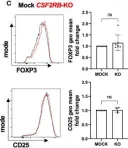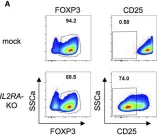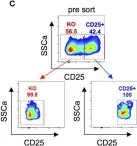Clostridioides difficile is a toxin-secreting bacteria that is an urgent antimicrobial resistance threat, with approximately 25% of patients developing recurrent infections. Inflammatory bowel disease (IBD) patients are at increased risk of severe, recurrent C. difficile infection.
To investigate a role for C. difficile infection in IBD pathogenesis, we collected peripheral blood and stool from 20 each of ulcerative colitis patients, Crohn's disease patients, and healthy control subjects. We used a flow cytometric activation induced marker assay to quantify C. difficile toxin-specific CD4+ T cells and 16S ribosomal RNA sequencing to study microbiome diversity.
We found IBD patients had significantly increased levels of C. difficile toxin B-specific CD4+ T cells, but not immunoglobulin G or immunoglobulin A, compared with healthy control subjects. Within antigen-specific CD4+ T cells, T helper type 17 cells and cells expressing the gut homing receptor integrin β7 were reduced compared with healthy control subjects, similar to our previous study of non-IBD patients with recurrent C. difficile infection. Stool microbiome analysis revealed that gut homing, toxin-specific CD4+ T cells negatively associated with microbial diversity and, along with T helper type 17 cells, positively associated with bacteria enriched in healthy control subjects.
These data suggest that IBD patients, potentially due to underlying intestinal dysbiosis, experience undiagnosed C. difficile infections that result in impaired toxin-specific immunity. This may contribute to the development of inflammatory T cell responses toward commensal bacteria and provide a rationale for C. difficile testing in IBD patients.
© 2023 Crohn’s & Colitis Foundation. Published by Oxford University Press on behalf of Crohn’s & Colitis Foundation.
Product Citations: 85
In Inflammatory Bowel Diseases on 2 May 2024 by Cook, L., Wong, M. Q., et al.
-
Immunology and Microbiology
Deep phenotyping of post-infectious myalgic encephalomyelitis/chronic fatigue syndrome.
In Nature Communications on 21 February 2024 by Walitt, B., Singh, K., et al.
Post-infectious myalgic encephalomyelitis/chronic fatigue syndrome (PI-ME/CFS) is a disabling disorder, yet the clinical phenotype is poorly defined, the pathophysiology is unknown, and no disease-modifying treatments are available. We used rigorous criteria to recruit PI-ME/CFS participants with matched controls to conduct deep phenotyping. Among the many physical and cognitive complaints, one defining feature of PI-ME/CFS was an alteration of effort preference, rather than physical or central fatigue, due to dysfunction of integrative brain regions potentially associated with central catechol pathway dysregulation, with consequences on autonomic functioning and physical conditioning. Immune profiling suggested chronic antigenic stimulation with increase in naïve and decrease in switched memory B-cells. Alterations in gene expression profiles of peripheral blood mononuclear cells and metabolic pathways were consistent with cellular phenotypic studies and demonstrated differences according to sex. Together these clinical abnormalities and biomarker differences provide unique insight into the underlying pathophysiology of PI-ME/CFS, which may guide future intervention.
© 2024. This is a U.S. Government work and not under copyright protection in the US; foreign copyright protection may apply.
In The EMBO Journal on 18 September 2023 by Karger, A., Mansouri, S., et al.
Long noncoding RNAs (lncRNAs) influence the transcription of gene networks in many cell types, but their role in tumor-associated macrophages (TAMs) is still largely unknown. We found that the lncRNA ADPGK-AS1 was substantially upregulated in artificially induced M2-like human macrophages, macrophages exposed to lung cancer cells in vitro, and TAMs from human lung cancer tissue. ADPGK-AS1 is partly located within mitochondria and binds to the mitochondrial ribosomal protein MRPL35. Overexpression of ADPGK-AS1 in macrophages upregulates the tricarboxylic acid cycle and promotes mitochondrial fission, suggesting a phenotypic switch toward an M2-like, tumor-promoting cytokine release profile. Macrophage-specific knockdown of ADPGK-AS1 induces a metabolic and phenotypic switch (as judged by cytokine profile and production of reactive oxygen species) to a pro-inflammatory tumor-suppressive M1-like state, inhibiting lung tumor growth in vitro in tumor cell-macrophage cocultures, ex vivo in human tumor precision-cut lung slices, and in vivo in mice. Silencing ADPGK-AS1 in TAMs may thus offer a novel therapeutic strategy for lung cancer.
© 2023 The Authors. Published under the terms of the CC BY NC ND 4.0 license.
-
FC/FACS
-
Biochemistry and Molecular biology
-
Cancer Research
-
Cell Biology
-
Genetics
-
Immunology and Microbiology
Modular pooled discovery of synthetic knockin sequences to program durable cell therapies.
In Cell on 14 September 2023 by Blaeschke, F., Chen, Y. Y., et al.
Chronic stimulation can cause T cell dysfunction and limit the efficacy of cellular immunotherapies. Improved methods are required to compare large numbers of synthetic knockin (KI) sequences to reprogram cell functions. Here, we developed modular pooled KI screening (ModPoKI), an adaptable platform for modular construction of DNA KI libraries using barcoded multicistronic adaptors. We built two ModPoKI libraries of 100 transcription factors (TFs) and 129 natural and synthetic surface receptors (SRs). Over 30 ModPoKI screens across human TCR- and CAR-T cells in diverse conditions identified a transcription factor AP4 (TFAP4) construct that enhanced fitness of chronically stimulated CAR-T cells and anti-cancer function in vitro and in vivo. ModPoKI's modularity allowed us to generate an ∼10,000-member library of TF combinations. Non-viral KI of a combined BATF-TFAP4 polycistronic construct enhanced fitness. Overexpressed BATF and TFAP4 co-occupy and regulate key gene targets to reprogram T cell function. ModPoKI facilitates the discovery of complex gene constructs to program cellular functions.
Copyright © 2023 The Authors. Published by Elsevier Inc. All rights reserved.
Differential regulatory T cell signature after recovery from mild COVID-19.
In Frontiers in Immunology on 28 March 2023 by de Sousa Palmeira, P. H., Peixoto, R. F., et al.
Severe acute respiratory syndrome coronavirus 2 (SARS-CoV-2) is characterized by a range of symptoms in which host immune response have been associated with disease progression. However, the putative role of regulatory T cells (Tregs) in determining COVID-19 outcomes has not been thoroughly investigated. Here, we compared peripheral Tregs between volunteers not previously infected with SARS-CoV-2 (healthy control [HC]) and volunteers who recovered from mild (Mild Recovered) and severe (Severe Recovered) COVID-19. Peripheral blood mononuclear cells (PBMC) were stimulated with SARS-CoV-2 synthetic peptides (Pool Spike CoV-2 and Pool CoV-2) or staphylococcal enterotoxin B (SEB). Results of a multicolor flow cytometric assay showed higher Treg frequency and expression of IL-10, IL-17, perforin, granzyme B, PD-1, and CD39/CD73 co-expression in Treg among the PBMC from the Mild Recovered group than in the Severe Recovered or HC groups for certain SARS-CoV-2 related stimulus. Moreover, Mild Recovered unstimulated samples presented a higher Tregs frequency and expression of IL-10 and granzyme B than did that of HC. Compared with Pool CoV-2 stimuli, Pool Spike CoV-2 reduced IL-10 expression and improved PD-1 expression in Tregs from volunteers in the Mild Recovered group. Interestingly, Pool Spike CoV-2 elicited a decrease in Treg IL-17+ frequency in the Severe Recovered group. In HC, the expression of latency-associated peptide (LAP) and cytotoxic granule co-expression by Tregs was higher in Pool CoV-2 stimulated samples. While Pool Spike CoV-2 stimulation reduced the frequency of IL-10+ and CTLA-4+ Tregs in PBMC from volunteers in the Mild Recovered group who had not experienced certain symptoms, higher levels of perforin and perforin+granzyme B+ co-expression by Tregs were found in the Mild Recovered group in volunteers who had experienced dyspnea. Finally, we found differential expression of CD39 and CD73 among volunteers in the Mild Recovered group between those who had and had not experienced musculoskeletal pain. Collectively, our study suggests that changes in the immunosuppressive repertoire of Tregs can influence the development of a distinct COVID-19 clinical profile, revealing that a possible modulation of Tregs exists among volunteers of the Mild Recovered group between those who did and did not develop certain symptoms, leading to mild disease.
Copyright © 2023 de Sousa Palmeira, Peixoto, Csordas, de Medeiros, de Azevedo, Veras, Janebro, Amaral and Keesen.
-
FC/FACS
-
COVID-19
-
Immunology and Microbiology
In Front Immunol on 20 December 2022 by Côrte-Real, B. F., Arroyo Hornero, R., et al.
Fig.6.C

-
FC/FACS
-
Collected and cropped from Front Immunol by CiteAb, provided under a CC-BY license
Image 1 of 3
In Front Immunol on 20 August 2021 by Van Zeebroeck, L., Arroyo Hornero, R., et al.
Fig.4.A

-
FC/FACS
-
Collected and cropped from Front Immunol by CiteAb, provided under a CC-BY license
Image 1 of 3
In Front Immunol on 20 August 2021 by Van Zeebroeck, L., Arroyo Hornero, R., et al.
Fig.4.C

-
FC/FACS
-
Collected and cropped from Front Immunol by CiteAb, provided under a CC-BY license
Image 1 of 3


